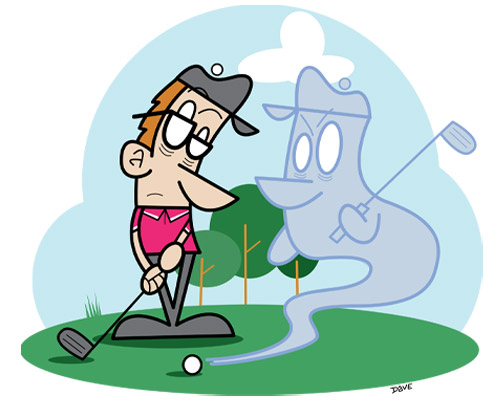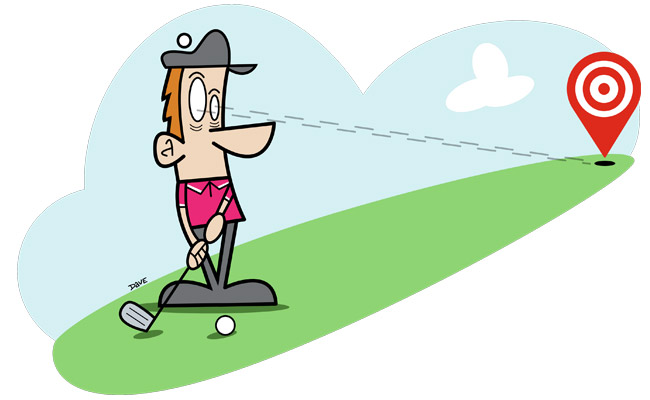CSU Grad Davis Bryant Discusses His Rise as a Pro Golfer
Colorado State grad Davis Bryant discusses his rise as a pro golfer and what keeps him busy when he’s off the course
By Lauren Howe/Illustrations by Dave Palmer
BEFORE A ROUND with your friends, how often have you found yourself in a groove on the range? The rhythm … the effortless swing … the crisp contact … the shaped shots—all perfect. As you head to the first tee, you’re already counting the money you’ll win from your buds.
Then you confidently step up on the first hole. It’s a tight par-4, where last week you needed a “breakfast ball” to save triple-bogey.

That’s not happening today, you think, but as you slide your tee into the ground, you remember last week’s mulligan-prompting shank into the trees. You tell yourself it won’t happen again and address the ball.
What ensues is a Zorro-like swipe at the ball that bears no resemblance to the smooth, easy swings you took on the range. Your driver bounces behind the tee, catches the top of the ball and skips it into the underbrush.
What just happened? How did you turn from awesome to awful? You didn’t. What changed was your state of mind because of where you chose to direct your focus.
I call this the “Phantom of Mis-hit Shots,” and banishing him requires both improving your emotional state of mind and redirecting your mental focus.
Your emotional state of mind is a reaction to something in your environment or something you are thinking. The way you feel represents your “point of attraction” or where you are focused.
When a negative thought or memory activates the paleomammalian cortex—the part of the brain responsible for controlling memory, emotion and behavior—your brain can become its own worst enemy. The memory of a poor shot, which can manifest itself as the Phantom, can induce a negative emotional state, which then affects your behavior and causes you to make mistakes. The good news is that you have the ability to redirect any emotion that does not support your goal to one that does.

So how do you do that?
Emotions exist to connect your mind to your body. How you feel physically impacts your mental state, and vice versa. Emotions act as an internal GPS system, helping you to navigate through the world while constantly calibrating how you feel and what you think. And because golf is such a mental game, being in a positive state of mind is crucial to success.
Your state of mind translates directly into results (see chart below). Given this chain reaction, how different would your golf experience be if you were consistently able to create a calm and confident state of mind? You could banish the Phantom forever.
The two main components that comprise any state of mind are emotional focus and mental focus.
Emotional Focus: How you feel emotionally results from how you inhabit your body physically. Think about how your body is positioned when you’re sad: shoulders slumped, eyes down, shallow breathing. This actually creates brain chemistry that creates sad thoughts.
To shift to a confident state of mind, you have to change your body position. Stand confidently, eyes up, and take a nice deep belly breath. As you exhale, let the tension in your body release with it. You have opened a new neuropathway, creating alternative brain chemistry that releases confident thoughts. This will allow you to view yourself and your golf abilities through a more positive lens.
Mental Focus: Once you have repositioned your body to open new neuropathways, shift the focus to your mental target. Positive self-talk can enhance how you feel about yourself, which consequently can improve your performance. Instead of berating yourself for a missed shot, redirect your focus to improving your next shot by telling yourself some positive thoughts.

The simplest, most effective way to visually direct your focus is to choose a specific target. A tree trunk, the left side of a bunker or a spot where you want the ball to land are all potential options. The clearer you can make that picture, the more focused you are on your target. The better you focus on your target, the more naturally your body moves, which improves your shot. Try this: If you are having trouble getting through the ball, focus on the target (not the ball or a backswing thought) and your body will move much more efficiently and athletically towards your target.
If you want to change your reality, change your focus. The two best questions you can ask yourself on the golf course are:
1. What do I want?
2. Where’s my target?
What you see in your “mind’s eye” becomes your reality. Shifting your mental focus will help you to re-center and reclaim the remainder of the round. Leave the phantom behind as you regulate your emotional response and mental attention. Feeling serene and composed will allow you to concentrate on the target and resuscitate your game.
The pre-shot routine is one of the most significant factors in the improvement and consistency of your golf game. It is also the most overlooked. The pre-shot routine is so important because 100 percent of your shots are affected by your thoughts and feelings, and all of your decisions are made before you swing. You need to take time to synchronize your mind and body.
All good players have a consistent pre-shot routine. Here’s how you can improve yours.
1. Stand behind your ball, facing your target. Stand very confidently, head up, strong in your spine.
2. Keeping your back elongated and steady, take a deep breath. When you exhale, release the tension in your body to create a state of calm and confidence.
3. Pick a specific target in the distance. This is where you will direct your mental focus.
4. Pick an intermediate target (one to three feet in front of the ball).
5. Line up the clubhead to the intermediate target.
6. Set your body up to the clubhead, making sure you step out parallel to the target line (and not towards your intermediate target).
7. Once you are set up properly, take another look at the target. Focus on the target until you have a really good sense of where it is.
8. When you have a strong sense of the target, look back at the ball, keeping your mind’s eye on the target.
9. Maintain that mental image as you swing through (not at) the ball towards the target. Don’t stop visualizing your target until your shot is soaring through the air.
Former LPGA Tour professional and Colorado Golf Hall of Fame member Lauren Howe is a golf instructor specializing in Neuro- Linguistic Programming and Neuro-Associative Conditioning. Reach her at 303-653-4442 or [email protected].
This article appeared in the 2019 Fall Issue of Colorado AvidGolfer.
Colorado AvidGolfer Magazine is the state’s leading resource for golf and the lifestyle that surrounds it, publishing eight issues annually and proudly delivering daily content via coloradoavidgolfer.com.
Colorado State grad Davis Bryant discusses his rise as a pro golfer and what keeps him busy when he’s off the course
The staff at Dream Makers Landscape is ready to help you enhance the look and feel of your property with our exceptional landscaping projects